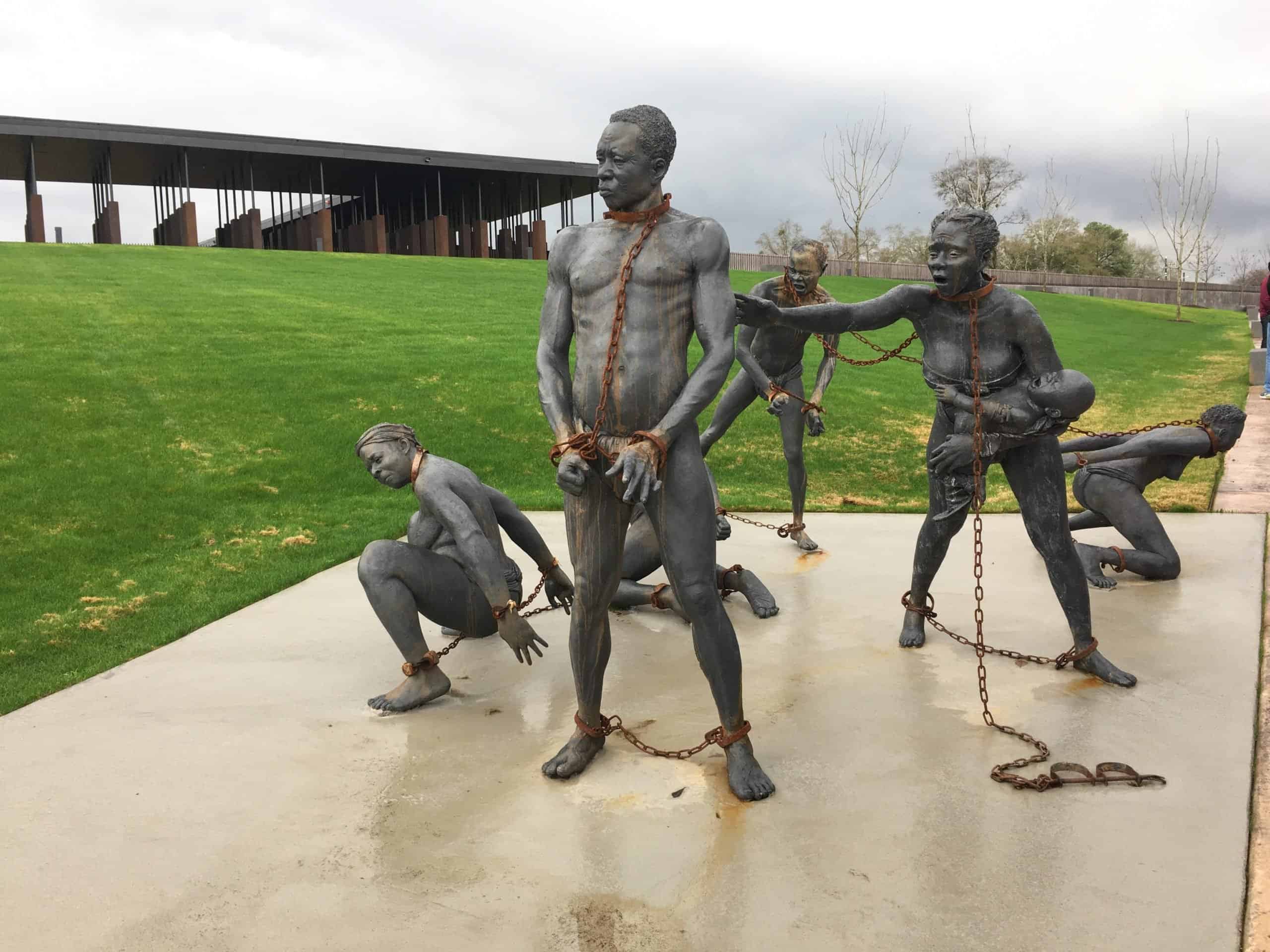There may be no place in the United States as intentionally constructed as the National Memorial for Peace & Justice of the Equal Justice Initiative. Right down to the bricks used, it seems every inch of the memorial was carefully and delicately designed. There are a number of layers to history and optics of the memorial that begin even before entering. It struck me that metal detectors were in use, especially since the memorial is entirely outdoors. What is more, a private security team monitors the perimeter of the memorial. It’s not possible to enter into, be in, and learn from this place and space without constant monitoring, not unlike the lives of the people it seeks to memorialize.
Wooden planks at the memorial entrance create the feeling of entering a jail cell. In fact, it creates the feeling of being in the hold of a ship. That is, visitors enter into their visit and experience at the memorial mimicking the position of a slave. Perhaps if that’s somehow lost on anyone, a sculpture confronts all visitors to make the point clear.
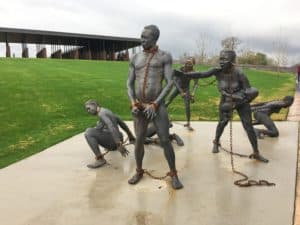
The entire memorial is at once overwhelming and understated. There is not much by way of text, artwork, or other images to get lost in, either. Instead, the plainness of the memorial perhaps speaks to how little most visitors actually know about the history being shared, and how simple the facts of the matter are. Legal decisions are summarized in comments smaller than Tweets. They are haunting.
It was not until the end of this opening walk that I noticed that the footprint of the entire memorial was in the shape of a ship. The sharp angles, the wooden planks, both underfoot and as side rails, serve to create not only the look, but even the sound of walking on the deck of a ship. It is not an accident, then, that some of the memorial coffins, hanging from the only roof of the entire memorial, actually hang over the edge, as if to symbolize those who were both enslaved and killed before making it ashore. What were their stories? What were their names? Were they sick and tossed overboard to prevent the further spread of disease? Were they killed for plotting to overthrow the slave traders themselves? Did they jump overboard in an attempt to swim to freedom?

Of course, the number of memorial coffins is astounding, but so is how they are displayed. Placed, at first, close together, visitors have to weave through coffins that appear at eye level, as if brushing shoulders with those on an overcrowded slave ship. Suddenly, the coffins hang from the roof, having already left stains down below from the erosion of its metal structure, as if footprints.
Eventually, the coffins hang higher and higher, or more accurately, the visitors descend lower and lower so that, quickly, they are forced to strain and squint to read the locations and names of those who were lynched. As the coffins themselves get further from view, detailed court documents come into view. The contrast is clear between these long and complicated court documents and the horrifyingly over simplified legal decisions. If visitors were to get lost reading these, they would actually end up walking off a cliff, perhaps a nod to the danger, harm, and depression that such a study could inflict upon others. A memorial though it may be, not all the names can be read because the coffins hang too high for visitors to read. That is, no matter how hard we try, there is a limit to how much we will truly know.
And then, just as soon as your eyes have adjusted to the squinting, visitors are confronted with the words of Toni Morrison, oversized and overwhelming, but simple. The heart is what matters.
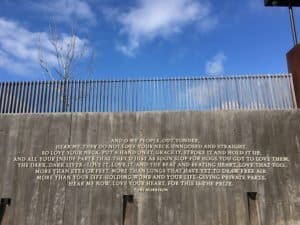
“…And O my people, out yonder, hear me, they do not love your neck unnoosed and straight. So love your neck; put a hand on it, grace it, stroke it and hold it up. and all your inside parts that they’d just as soon slop for hogs, you got to love them. The dark, dark liver–love it, love it and the beat and beating heart, love that too. More than eyes or feet. More than lungs that have yet to draw free air. More than your life-holding womb and your life-giving private parts, hear me now, love your heart. For this is the prize.” –Toni Morrison
Ironically, visitors then view an extensive display of coffins, this time not hanging, but laying, as if waiting for burial. In fact, they are. The Equal Justice Initiative is willing and wanting to work with any municipality or county which is willing to properly memorialize the deaths that took place on its own soil. Perhaps what is most overwhelming is how many coffins remain unclaimed, unwanted, ignored. Exposed coffins can be unnerving to see, especially so many all at once, but what perhaps should be even more unnerving is the fact that most of the people killed were likely not even given the dignity of a burial.
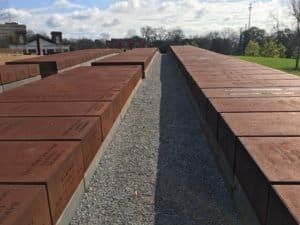
Visitors do not leave the memorial without hope. Visitors must brush shoulders with statutes of the boycotters that walked the very same streets. Ironically, if a visitor were to stand at eye-level, and in the same direction as the statues, the view they would see is much like that of a landfill — an odd terracing of the hill on which the majority of the memorial sits, perhaps meant to signify the messy, man-made results of man’s own creation and racism. The protestors must necessarily be like the tall, strong pines in whose shadows they stand.
Even a visitor’s exit from the memorial is calculated. There are no quick exits. It takes time to leave. Visitors must walk through a painfully slow, winding path that leads to the largest sculpture on the grounds. At first sight, the figures appear as enslaved persons drowning at sea, or perhaps simply stuck in a wall, with only their raised hands, heads, and chests exposed. Perhaps it is only as visitors walk behind the sculpture that they may realize its intended commentary on police brutality and shootings.
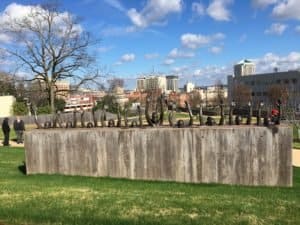
My timely prayer is that no memorial like this need be made ever again. With the racism now being perpetuated against Asians as a result of COVID-19, I will be praying all the more.
A note about the pilgrimage: The Jesuit Antiracism Sodality, formed by Jesuits in formation to confront racism, hosted a Civil Rights Movement Pilgrimage earlier this year. Beginning in New Orleans, and traveling to Mobile, Selma, Montgomery, Birmingham, before ending in Atlanta, men in formation from the Midwest and Central and Southern Provinces visited historical sites, museums, and met with Black Catholic leaders along the way, including Joseph Brown, S.J., professor of Africana Studies at Southern Illinois University.
-//-
Photos by Mike Price, n.S.J.

